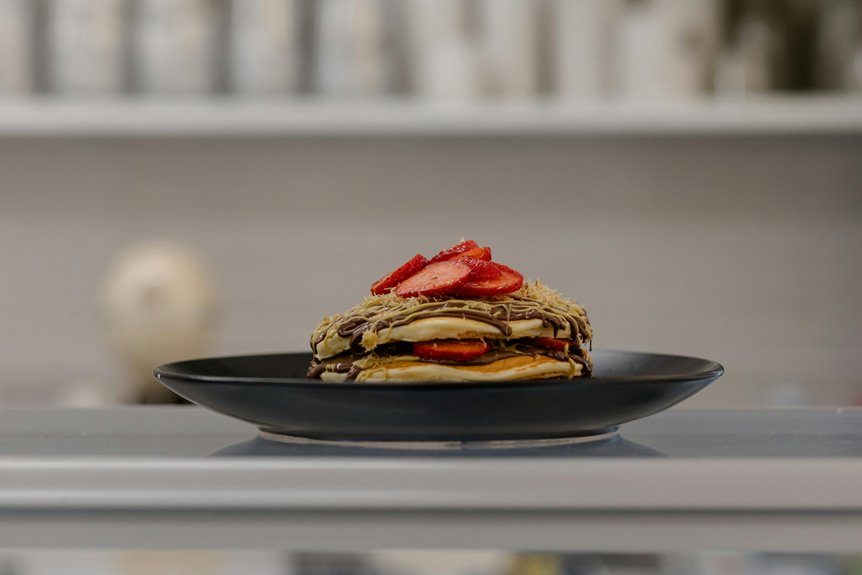You can put some crepe fabrics in the dryer, but only if you use the lowest heat and handle them very gently. High heat and tumbling can shrink the fabric, cause pilling, and ruin the texture you love. To keep your crepe looking its best, air drying or using a delicate cycle inside-out is safer. There’s more to know about protecting your crepe’s shape and color, so keep going to get all the expert tips.
Table of Contents
Key Takeaways
- Crepe fabric is sensitive to heat and can shrink or lose shape if dried in a high-heat dryer.
- Using a dryer may cause crepe fibers to weaken, leading to pilling and texture damage.
- If using a dryer, select the lowest heat or delicate setting and remove garments promptly.
- Air drying crepe flat or on padded hangers is safer and preserves fabric texture and shape.
- Always follow the garment’s care label instructions to prevent damage during drying.
Understanding Crepe Fabric and Its Properties
Crepe fabric features a distinctive crinkled texture that sets it apart from other materials. When you handle crepe, you’ll notice its lightweight and slightly rough surface, which gives it excellent drape and flow.
This texture results from the unique weaving technique or the use of highly twisted yarns. You’ll find crepe made from various fibers such as silk, wool, polyester, or cotton, each offering different levels of softness and durability.
Because of its delicate weave, crepe tends to wrinkle less but can be sensitive to heat and rough handling. Understanding these properties helps you make informed decisions about care, especially when it comes to washing and drying, ensuring your crepe garments maintain their distinct texture and shape over time.
Risks of Using a Dryer for Crepe Garments
Although using a dryer might seem convenient, it can easily damage your crepe garments. The heat and tumbling action can cause shrinkage, weaken fibers, and ruin the fabric’s delicate texture. You’ll risk fading colors or creating unwanted wrinkles that are hard to remove. Here’s a quick look at common risks when drying crepe in a machine:
| Risk | Effect on Crepe Garments |
|---|---|
| High Heat | Shrinks fabric, distorts shape |
| Tumbling Action | Weakens fibers, causes pilling |
| Prolonged Drying | Fades colors, dulls appearance |
| Excess Moisture | Leads to mildew, bad odors |
| Wrinkling | Creates deep-set wrinkles |
Avoiding these risks helps maintain your crepe’s look and longevity.
Best Practices for Drying Crepe Safely
When you want to keep your crepe garments looking fresh, drying them properly is key. First, always check the care label for specific instructions before you start.
If you decide to use a dryer, choose the lowest heat setting or a delicate cycle to minimize damage. Turn your crepe item inside out to protect the fabric’s surface. Remove the garment promptly once the cycle ends to prevent wrinkles.
Avoid overloading the dryer, as this can cause unnecessary friction and creasing. Use a mesh laundry bag to add an extra layer of protection.
Finally, if you notice any lingering dampness, lay the crepe flat on a clean towel to air dry completely. These steps help maintain your crepe’s texture and shape.
Alternatives to Machine Drying for Crepe
If you want to preserve the delicate texture of your garment, skipping the dryer can be a smart choice. Instead, lay your crepe item flat on a clean towel to air dry, reshaping it gently to avoid wrinkles.
Hanging your crepe on a padded hanger in a well-ventilated area also works well, letting gravity naturally smooth out the fabric. Avoid direct sunlight to prevent fading.
You can also use a drying rack, ensuring air circulates evenly around the fabric. These methods help maintain the garment’s form and softness without exposing it to heat or tumbling damage.
Tips for Maintaining Crepe’s Texture and Shape
To keep your crepe looking its best, handle it gently during washing and drying to prevent damage to its unique texture.
Crepe’s delicate fibers need special care to maintain their distinctive crinkled appearance and shape.
Here are four tips to help you preserve your crepe’s texture and shape:
- Always wash crepe in cold water using a mild detergent to avoid fiber stress.
- Avoid wringing or twisting the fabric; instead, press out excess water gently.
- Lay the garment flat on a clean towel to air dry, reshaping it while damp.
- Store crepe items on padded hangers or folded neatly to prevent stretching or creasing.
Follow these steps, and you’ll keep your crepe looking fresh and flawless for longer.
Frequently Asked Questions
Can Crepe Fabric Be Ironed Without Damaging It?
You can iron crepe fabric, but you’ve got to be careful. Use a low heat setting and place a pressing cloth between the iron and fabric to prevent damage. Avoid pressing too hard or leaving the iron in one spot.
What Types of Crepe Fabric Are Most Durable?
You’ll find wool crepe and silk crepe quite durable, thanks to their strong fibers. Polyester crepe also holds up well and resists wrinkles. These types can handle regular wear better than delicate crepes like chiffon.
How Do You Remove Stains From Crepe Clothing?
Wondering how to tackle stains on your crepe clothing? Don’t rush—dab gently with cold water and mild detergent. Avoid scrubbing, then air dry. This careful approach keeps your delicate fabric looking flawless every time.
Is Crepe Fabric Suitable for Summer Wear?
You’ll find crepe fabric suitable for summer wear because it’s lightweight and breathable. Its texture allows air circulation, keeping you cool and comfortable even in warmer temperatures. Just choose lighter colors for extra heat reflection.
Can Crepe Fabric Be Dry Cleaned Safely?
You might worry dry cleaning could damage delicate crepe, but it’s actually a safe option. You can trust professionals to handle crepe carefully, preserving its texture and color without the risks of home washing or drying.
- How to Get Wrinkles Out of a Crepe Dress (4 Methods, No Iron Needed!) - June 23, 2025
- Can You Put Crepe in the Dryer? The Definitive Answer - June 23, 2025
- How to Wash Crepe Fabric (Hand Wash & Machine Wash Instructions) - June 23, 2025







